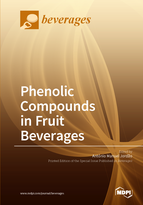Phenolic Compounds in Fruit Beverages
A special issue of Beverages (ISSN 2306-5710).
Deadline for manuscript submissions: closed (30 November 2017) | Viewed by 80588
Special Issue Editor
2. CQ-VR, Chemistry Research Centre, 5000-801 Vila Real, Portugal
Interests: wine; grapes; phenolic compounds; enology; winemaking; wine aging process
Special Issues, Collections and Topics in MDPI journals
Special Issue Information
Phenolic compounds, also called polyphenols, constitute a diverse group of secondary metabolites that exist in plants and their fruits. This important group of compounds contributes to organoleptic characteristics, such as color, taste, astringency and bitterness of fruit beverages. In addition, these compounds have gained considerable interest due to research suggesting their many health benefits especially as antioxidants.
Thus, the objective of this Special Issue is to publish a compilation of original research and review papers that cover different aspects of phenolic compounds in fruit beverages, such as fruit composition, varieties and factors that could affect their phenolic composition, analytical methods for phenolic identification and quantification, impact of fruit beverages technologies on phenolics, role of phenolics in the sensorial analysis of fruit beverages and the biological activities and the health benefits of fruit beverages polyphenolics.
Prof. Dr. António Manuel Jordão
Guest Editor
Manuscript Submission Information
Manuscripts should be submitted online at www.mdpi.com by registering and logging in to this website. Once you are registered, click here to go to the submission form. Manuscripts can be submitted until the deadline. All submissions that pass pre-check are peer-reviewed. Accepted papers will be published continuously in the journal (as soon as accepted) and will be listed together on the special issue website. Research articles, review articles as well as short communications are invited. For planned papers, a title and short abstract (about 100 words) can be sent to the Editorial Office for announcement on this website.
Submitted manuscripts should not have been published previously, nor be under consideration for publication elsewhere (except conference proceedings papers). All manuscripts are thoroughly refereed through a single-blind peer-review process. A guide for authors and other relevant information for submission of manuscripts is available on the Instructions for Authors page. Beverages is an international peer-reviewed open access quarterly journal published by MDPI.
Please visit the Instructions for Authors page before submitting a manuscript. The Article Processing Charge (APC) for publication in this open access journal is 1600 CHF (Swiss Francs). Submitted papers should be well formatted and use good English. Authors may use MDPI's English editing service prior to publication or during author revisions.






